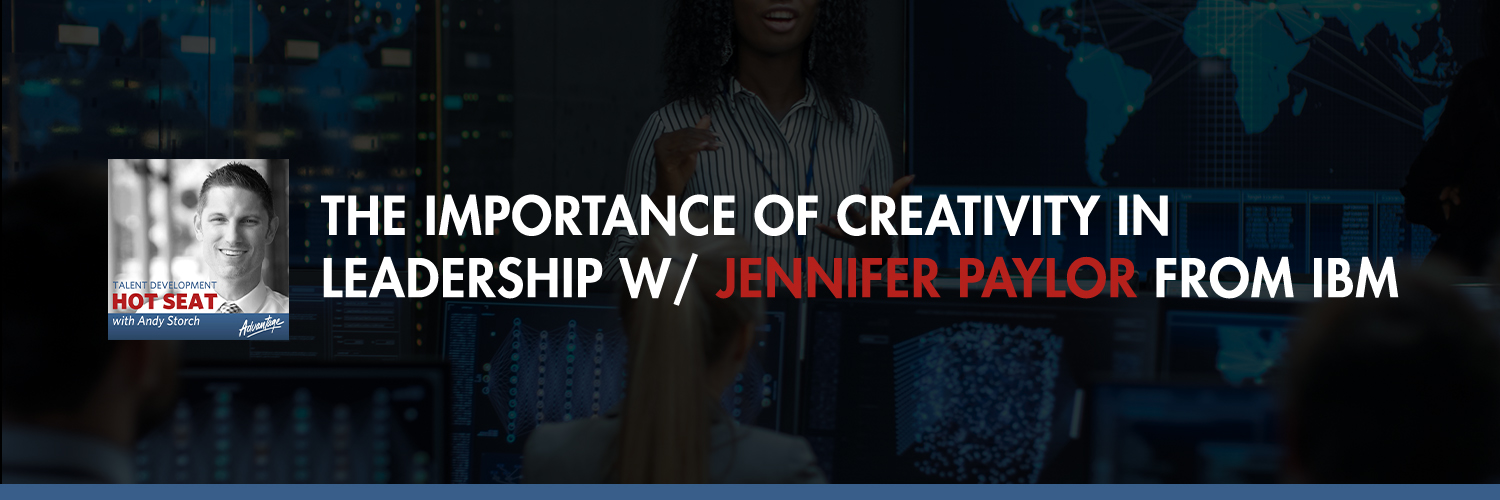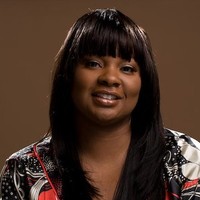
The importance of creativity in leadership
Good things happen when you are in tune with who you are."
In the Hot Seat: Jennifer Paylor from IBM on creativity in leadership development
Reaching better heights for talent development requires an updated and creative leader. In this episode, Andy Storch interviews IBM Coaching Leader, Jennifer Paylor as she proves how creativity in leadership development can positively change the way employees work.
Jennifer is a visionary, a “people engineer,” and leader who builds cultures for modern organizations. Her journey to talent development and leadership is a challenging one, stemming from a dilemma between working as a singer or as an engineer.
Jennifer inspires us to align with our life vision regardless of how different we are from others. She then talks about bringing creativity to leadership and using it for talent and development trends.

Listen to the podcast here:
The importance of creativity in leadership w/ Jennifer Paylor from IBM
Why being more creative sparks more success as a leader
I am excited that you're joining me for an interview with my new friend, Jennifer Paylor. Jennifer is a visionary and bold people engineer and leader offering proven expertise driving exponential growth and organizational transformation through effective people development, employee and customer engagement, leadership coaching, management consulting, and strategic initiatives. Jennifer works in Executive Development at IBM, which has 350,000 members, employees across the globe. She is working on a book on leadership to be published sometime in 2020. Jennifer, welcome to the Talent Development Hot Seat.
Thank you, Andy. It’s nice to be here.
It’s great to have you on. We were connected by Whitney Johnson, who I interviewed and she had some great things to say about you and the work that you've been doing both at IBM and on your own. I’m eager to dig into some of that stuff. I know you're big on applying creativity to leadership development and you have a motto about Touching Lives. I want to get into that as well. Maybe you could start by sharing a little bit of your background and how you got to where you are.
Dilemma Between Singing And Engineering
I'm an artist by talent, by nature, and by skill. This is different for me because usually when I do presentations, I start by singing. I'll sing something and I’ll say, “Strumming my pain with his fingers. Singing my life with his words. Killing me softly with his song. Killing me softly with his song. Telling my whole life with his words. Killing me softly with his song.” That's how I started. I started off as a singer-songwriter when I was a young girl and I used to direct choirs. At some point in my life around twelve, I said, “This thing you think is cool,” but I've always loved math and science. I had this dream of either being a singer, engineer, or architect because I'm an artist. I started working with producers, writing and developing songs, and I started a group called Structure.
[bctt tweet="Leaders don't know when they are impressing someone that will help them make a decision that governs and directs their life" via="no"]
When I became a teenager, I was good at math and science and I was doing a lot of engineering things in high school. I had an opportunity, when I was nineteen, to sign a record deal with Sony or to join IBM as a video game developer. At the time, I had worked with many artists and producers. I've worked with 50 Cent, DMX, Wyclef Jean and some of the older names. As you might know, they're talented people. My record deal would have been working with, believe it or not, a guy named Swizz Beatz. He was on the up and coming at the time and he's married to Alicia Keys, so I had a decision. “Do I go in and continue my electrical engineering degree or do I take this singer record deal?”
I took the IBM deal and it has been worth it. I have enjoyed it. At this point in my career, I've done singing, I have been an engineer, consultant, business transformation, and delivery consultant. Also, I did a pivot and I'm doing leadership development and leadership coaching. As a people engineer, that's what my role is. I have the opportunity to architect many different things using creativity. I take pieces of math, science, philosophy, music, art, and I pulled them together to help leaders become better at what they do and try to impact lives across the company and in the world. That's how I became this people’s engineer, through art.
What an interesting story, and I'm sure there's a lot more to it. First of all, I want to say I've done over 200 interviews between my two shows and I don't think anyone has done any singing on the show yet. Your voice is beautiful, so you are a great first one for that. Thank you for sharing that with us. Second of all, I'm thinking of, “How many people have had to decide between a record deal or becoming an engineer at IBM?” It seems like two different worlds. The artist is the person that's not into math or science, and vice versa. You're unique in that. How did you approach that decision? That was a pivotal moment for your life.
At that moment, if I take my mind back, I remember the hard work that it took to get there, and the relationships and all the people that helped me grow as an artist. I remember the dream. I remember standing in the office on Sony and I sang a song by Celine Dion. It was the Titanic song or I'll Be Waiting For You, but I sang that song and they put the deal right in front of me at the time. I remember them saying, “We want you to be this other image.” They’re like, “You're pretty.” I was young and they said, “We want you to be the R&B’s Lil' Kim.” At that moment, that wasn't a vision I have for my life. I liked music and things. It was at the moment where I said, “No, I know who I am.”

Creativity In Leadership Development: The first thing a leader must do is realize who she/he is as a person.
The first thing leaders have to do is realize, “Who are you as a person and as a leader?” At that moment, that was how I made the decision. I had a clear vision of my identity. It didn't fit with the identity. Maybe I could have been wrong at the time, but that's how I made my decision. It didn't align with my vision and who I believe that I was. The decision was super easy for me. It was like, “If my mom sees me like this or that, which one would she be proud of?” She would be prouder of me being the engineer, working and getting paid 40 hours a week. Zelda video games were fun at the top. You get paid to play games was even better.
There are two things you said there that are interesting. One is important, which is that you tapped into your vision for your life, your purpose, and where you wanted to go. That made the decision so much easier. I know other people who have done that and there's a lot of people out there who are faced with these decisions. They don't know what to do because they don't have a clear vision for where they want to go. When you have a clear vision and you have clear values, that is, what are the things that you value? It's different for everybody and there are no right or wrong answers. Decisions then become easier when something comes to you and you can say, “Does this fit into my vision?” I had one of these one time. An opportunity came my way and I checked in with a coach I have. She said, “How is this aligned with your future vision where you want to go.” I said, “It doesn’t.” She said, “Great. The answer is easy and you turned it down. It's hard to turn these things down when they come up.” You also said what was your mom most proud of, which is important, but it doesn't necessarily have to align with your vision. In this case, they were a lot.
Aligning With Your Vision
They were aligned because I was nineteen. The only thing I knew at the time was the values, teachings, and guidance that my mom taught me. I also knew the guidance, principles, and teachings that these other giants in the industry taught me. A lot of celebrities that I was around were accomplished, successful, and wise, and they were successful in music. I had people telling me a lot of things at nineteen years old. I didn't even understand the decision-making process. The only thing I could hold on to was, “Here is my purpose. Here's how I stay true to who I am.” That's the only thing I knew to do. That's the reason why my mom came into play. I told her the story and she said, “I never knew that story.”
Sometimes, as leaders and as role models, you don't know when you are impressing upon someone in a way that will help them make a decision that will govern and direct their life. Even if you don't say anything to them and live a certain way, you are impacting and touching their life. Learning people are not always ready to learn. When it's time for people to make a decision and ready to learn, they look to people who have given them some sound, guidance, and wisdom. Hopefully, they take that data and can make a decision that they can live with, so I can live with the decision.
[bctt tweet="Good things happen when you are in tune with who you are." via="no"]
We're always faced with these tough decisions in life. They seem so hard at the time and then we make a decision, we move on. I always think, “We made the right decision. No matter what you do, you're going to make the right decision,” and then it's going to be part of your journey. You got into video game production at IBM, which I didn't think IBM was involved in video games at all.
IBM is a cool company. We've done everything. When I was nineteen, I went to school for electrical engineering. I was studying in undergrad. At the time, we had a personal computer called the Aptiva. Do you remember the black computers that IBM used to make? You had the ThinkPads and you had the personal computers, and they were called Aptiva. On the Aptiva multimedia personal computer, we had a slew of apps. Back then, we call them software. We had a lot of apps on there. On video games, we had some high-tech video rendering hardware and software. IBM was known to bring in that multimedia entertainment experience into your home. The computers had a home director.
I remember this hardware and software where IBM had its computer and you could turn your lights on. Nowadays, we have the internet of things. We had that at IBM. You could turn your stove and oven on at a certain time. You could turn your lights on at a certain time. This was back in the late ‘90s. We had these video games that we could play. Some of the video games were Duke Nukem, which was popular back then. We had Rome and all types of these similar games that we have like building civilizations and cool stuff, but it was fun. We had a huge gaming lab. A lot of adults are programming games and beating each other up on the games and competing. It was a fun space. IBM has been involved in a lot.
I had no idea that they were doing all that stuff and fun things. You've been there for a few years. How did you move from engineering into the space that you're in, getting into coaching and executive education and that stuff? It’s a big shift.

Creativity In Leadership Development: In the corporate world, it doesn’t matter whether there are different races.
From Engineering To Coaching
Halfway through my career, I was a total geek. I was a total lab person. I stayed in the lab for ten years of programming and designing. I would go around the world to different countries and different places where we had to bring up different manufacturing sites across the world. One of the things that fascinated me as an engineer about systems and processes was that we can design in a simple context. Back then it was simple and now, things are more complex. The technology was designed to last forever. It wasn't as fast-paced. I said, “I can program this. I can design this and it would last for a long time,” but the interactions from people, the way people were thinking about it, and how they interact with the system, it fascinated me. The person was a component in the system that you can't control. There were controlled objects. You can create this hardware that you can design that would be stable, but the person introduced another component in that system that fascinated me.
I thought about how people operate in the system and I love the way that people thought and the things they came up with. It was beautiful, so I wanted to work more with people. I wanted to start training people consulting and learning from people. I spent a lot of time developing engineers and other people who were coming up in the company. I said, “I want to do external people. I want to go outside of IBM.” I got into business transformation, consulting, helping our external clients in IBM transform their business using creativity, art, and some of the skills that I had developed over time and transfer. I said, “I'm ready to leave engineering after about ten years.” Ten years in engineering back then is a long time. I wanted to take that leap and pivot. I went back to school and I studied leadership development, and I fell in love with how you develop leaders. I went back to school and got certified in executive business coaching. That's how I moved into the area.
I started branding myself, putting myself out there for this type of work. I got an opportunity to build a talent development group inside of one of the businesses at IBM. I remember talking to the director and I said, “I went back to school and I want to do more of this people thing.” He said, “Whenever you have an opportunity in your group to build up something for people, let me know.” A year later, he walked up to my desk and he said, “Jennifer, we are going to bring on this group called the Millennials.” He said, “You're like an older Millennial. We're not quite sure but you're right on the lines.” I said, “I may be a Gen X.” He’s like, “Whatever you want to call it.” He says, “Can you build up a talent development team?” I said, “From the ground up?” He says, “Yes, you're an engineer. You're an architect. You're a builder.” I said, “Yes, but I need some help.”
He brought in a leader who has been at IBM for about many years. He's a super genius and creative person. Together, we constructed this talent development team for tens of thousands of employees. The rest is history. He has developed a lot of skills and is having fun. I moved into corporate leadership development. I wish I could say that I strategically planned it, but it's not about strategy. It was more about passion, being creative and taking a chance on what I believed in. Good things happen when you are in tune with who you are.
Importance Of Creativity In Leadership
[bctt tweet="Creativity is a skill that you can learn which helps people see things in a different way." via="no"]
I want to ask you about the talent development group that you built and get into a little bit of that executive development. I want to ask you one more question about your personal story because we often don't get that personal on this show. I've been having more guests and more conversations about diversity and inclusion becoming an important topic. You are a black woman in a world that I imagine is dominated by white men wearing blue button-down shirts in IBM engineering. What was that like? How did you make your mark and build a successful career being different than everybody else?
Building A Successful Career As A Black Woman
“Yes, I'm a black woman and I've been black all my life.” That's what I tell people. Do I know what it feels like? Yes, I've been black all my life. As a young girl, my mother told me, “Jennifer, in this world, it's going to be super hard for you. You're smart. You're graduating as the top six in your class. You're different. You are going to have to work twice as hard.” She kept telling me that from when I was a child. I didn't realize that she was right. In my career at IBM, I have been fortunate enough to get some people who saw me for who I was. When I was nineteen, that was my first year. I was eighteen when I got the job and nineteen when I started. Most people start working in an internship when they are junior or senior. I got an opportunity from a lady named Norma Fries. She was a white lady, and she said, “I'm hiring for one person, but I got 300 people that I interviewed.” She gave me the chance and she saw me for who I was.
I had another opportunity with one of my managers from Persia and a man who was an engineer and he’s smart. He saw me for who I was. I had another white male manager who saw me for who I was and then I had some black colleagues and leaders who are not as helpful as some other colleagues. IBM is a diverse company. You don't see a lot of women in its leadership as much as you see males. You see more now, but when I started back then, it was rare. You don't see a lot of black women in leadership than it is more now, so it's hard. I have to work almost three times as hard as anybody else. I don't even think it's about race at this point. I know it's there. It’s always going to be there because I've been through it all my life. It’s more about my authenticity. There are some decisions that I have to make as a black woman. I hear things about, “Can you be more collaborative?”
If you talk to anyone about me in IBM, they’ll say, “Jennifer's collaborative. She works with everybody.” I do a lot of crowdsourcing and crowdfunding. Is that the face value? I'm a collaborative person, but what they're saying when it comes from a certain type of person is, “Jennifer, we don't want you to be as authentic or as colorful.” That's why I told you I sing. I didn't sing before. I would have been scared to sing, but I do sing and people know I can sing. Many years ago, I would have never told anyone at IBM that I could sing. My leader that I have, she asks me to sing and she sings. Things changed. You do have to realize the system you're in, but it's hard. There are some things that people have to get comfortable with and I have to get comfortable with them going along the journey, and growing. IBM is diverse. We have all types of races and all levels of leadership. I've seen that growth for many years, so I appreciate the opportunities that I have gotten by being who I am at IBM.

Creativity In Leadership Development: Learning is not just knowledge transfer. Learning is transformational.
Thank you for sharing that. You did tell me that you like to be truly authentic. I like to think everybody does, but in the corporate world, it doesn’t matter whether they're a different race or anything else. They oftentimes are holding something back and I'm seeing a movement where companies are saying, “We want people to be able to bring their whole selves to work and be authentic.” That's part of the diversity inclusion. We all have different backgrounds, stories, points of view, and experience, and we want people to be able to be themselves. To a certain extent, some things can be distracting, but for the most part, if you like to sing, sing. If you like to dance, dance. I dance in meetings. It's being willing to put yourself out there and be your whole self, that's great. You mentioned you had that opportunity to build that talent development group. I have a lot of readers who are building talent development groups. People have reached out to me and most of them are much smaller companies. They're building things from scratch and may not quite have the resources that IBM does or had. What were a couple of keys to your success there in building a successful talent development group from scratch?
Reasons For Building A Talent Development Team
One thing is listening to mentors and listening to what the problems are in the business. What is the business challenge? There's a reason why you want to build a talent development team or group. The obvious reason is not what I'm talking about, but there's a business reason why you had to do this. Number one is to always align it to a business challenge. What is it there to do to serve the business? The other thing that is important is soliciting help. It was one person and then I had two. We did it together, but solicit help from the people. What I mean with people is the people that you're developing the talent. One of the things that I did was I never develop talent development in a box. You can't put talent development on a person. You have to engage the people and involve them because behaviors are hard to change. Learning is not only knowledge transfer. Learning is transformational, so you have to involve these people that you're developing are your clients.
The third thing that I always say is to be creative. There are a lot of things that when I started, people said, “We have different training classes across the company that we are doing and people are consuming,” but be creative. Do one thing. I used to say, “I'm going to clean the closet.” People say, “What is that?” Looking at all of the different training activities, offerings and programs that might exist across the enterprise and how people are consuming them. Sometimes, it's a lot of stuff, but people are not even consuming it. I cleaned the closet. I will go into my closet, into the offering or portfolio, and say, “We're not using that. Throw it out.” The only thing we need is five outfits. Let's wear these five outfits well and go deep on it. That has been helpful because it's not simple, but it simplifies your strategy. You get to wear those outfits instead of them hanging in the closet. That's one of the things and I call it cleaning out that closet.
You were doing that before this whole movement started by Marie Kondo, The Art of Tidying Up. Everybody is throwing stuff out, at least in their literal closets, but you're doing it in the figurative closet there and streamlining and simplifying. You mentioned creativity and I know this is a big thing for you. You started out as an artist and you are still bringing that to what you do at work. You talked about how you like to bring creativity to leadership and use that in leadership. I'm wondering, tell me more about that approach. Why do you think creativity is important in leadership? It's not something that I hear often being linked together.
Creativity is a skill that you can learn and it helps people see things differently. I don't know if you've heard of David Snowden. I'm going to give him credit because I love his model. David Snowden has this Cynefin framework and there are four different areas in this framework. One of these is complex. The idea is most of the time, we're in this complexity type of system and leaders are trying to navigate complexity. Many leaders, believe it or not, underestimate how difficult it is to navigate complexity. The reason they do is because they don't have creativity. I was a process engineer, so I used to develop processes and procedures. When you’re developing a process, David Snowden’s Cynefin framework calls that simple or obvious type of environment.
[bctt tweet="We are creatures of habit, so we get in a habit of applying the same thing over and over and over." via="no"]
You have a cause and effect of something that happens the same way every time, so you can solve for and you can say, “If this happens, here's the process I'm putting in place. Here's the rule that I'm putting in place,” and you capture it. In complexity, it may only happen once. The cause and effect may be incoherent, so the only thing you have is the creativity skill where you can create something that you've never done or that somebody else has done, and you're applying it differently. Let's take lip gloss for example. There's a process for putting on lip gloss. I had a little bottle that has lip gloss in. I put the little applicator in it, I take it off and I put it on my lips. That's the process of putting on lip gloss. How do I apply that in the sense? How can you use that same concept when you're leading someone? Let's think about it. I'm at work and I'm a leader. I have an employee who's not engaged. Why? Maybe they need some lip gloss. Maybe there's something going on.
Why do we need lip gloss? It's glossy, so it helps you shine. What can we do in employee engagement to help someone extra shine? Give them some lip gloss. What does that mean in the workplace? You apply it every day or you apply it weekly. How about as a leader? How about offering some lip gloss to some people who may need to shine that normally don't wear lip gloss? That may be easy to understand or maybe it's difficult, but the point is, that it’s a creative way or model to think about a different way of doing something than what you normally would do in an obvious environment. If you were in an environment where you create a process for it, you probably would do the same thing all the time, but they don't need lip gloss all the time. It's about being creative and figuring out, “How can I apply that here?” Sometimes, it works.
I can't say that I've ever put lip gloss on but I understand what you're talking about. How do you build this into leadership development to help leaders become more creative at IBM or anywhere that you're working?
Breaking the rules and helping them do things that they would normally not do to unleash them. We are creatures of habit, so we get in the habit of applying the same thing over and over. One of the things I'm working on with Dr. Srini Pillay is how to bring in gospel music to help leaders become more inspirational and authentic. There are a lot of studies. Dr. Srini Pillay is a Harvard professor and psychiatrist who's done a lot of study on the brain and neuroscience. We have been creating a method where you can apply gospel music to the brain, heart, and soul to transform leadership. It's a different leadership development approach. Usually, in leadership development, we do training, take someone to a training class or do a virtual in person. We have some topics, do a workshop, they walk away and they say, “I know this stuff.” They go back to doing whatever they want to do is cool. Do you know what they say? “It was great to get together with everybody. It’s good to be together. We need to do this more often,” but they go back into their environment. They go back to doing the same thing.
When you think about music, especially gospel music, it touches the core of a person and who they are, and they have to deal with themselves. The creative part of it is we don't use gospel music and leadership development, but the brain responds well to gospel music. That's a lot of the research that Dr. Srini Pillay developed. That's one of the examples where we've been experimenting with the music. In my job, I will do an improv with leaders and I will also design different elements in their workshops that will stretch them out of the box. We’re making them a little bit uncomfortable, but more like liberating. One of the things I'm working on is doing improv with a little stage play to help leaders embody what it feels like in their body, mind, and brain on how to be inspirational. We’re doing a little acting there.

Creativity In Leadership Development: Peer-to-peer cohort provides a level of psychological safety or relief where they can bring their selves to it.
Bringing music, bringing acting, bringing performance, a lot of creativity, and creative aspects of life that you don't find much in the corporate world that you're bringing in to change how people think and get them thinking more creatively. I like that. I've heard of other companies doing things like that as well. It’s cool to hear. I want to keep in touch and hear how those things are going. In this career, you've had many years or so with IBM. What's been your greatest accomplishment?
Peer-To-Peer Cohort
I saw that in your email and I started thinking, what is my greatest accomplishment? It's hard for me to think like that, so I'll say it in another way. I am happy that I have been able to touch the lives of many IBMers in a different way. We have a program called Blue Core coaching. We have other programs called PALS and Beat. I designed them but each one of them touches the life of IBMers. We have IBMers in what I call the peer-to-peer cohort model. You heard of cohort tight learning models. I designed the environment in a way that provides a level of psychological safety, sanctuary, relief, freedom, and a sense of freedom of life where they can bring their whole selves to it. People come into those sessions and they say, “This has changed my life. It's changed me as a person.”
I had one story and she's okay with me sharing it. She learned this new skill in this environment. I took a chance on this coaching thing, and it is one of the coach skills training. She says, “I started using this coaching when my mom had a stroke. She couldn't move and she couldn't talk. It’s frustrating. I can't get through to my mom. She's frustrated and the doctors frustrated.” She started coaching her mom and she sent pictures from day three when her mom couldn't even read. It was what we call chicken scratch. She sent the picture 30 days later and she said, “This is a result of me being in that experience.” It's an experience that touches people's lives. Her mom's handwriting was beautiful. The point is she changed her own life, her happiness, and she uses that in work. We have thousands of people like that. What I'm happy to see is that people bring it and I'm able to be a small part of them having some happiness at work.
On the flip side, what's been one of your biggest mistakes or failures and what did you learn from it?
One of my biggest mistakes is trusting the wrong people. I will trust the wrong people because I believe in people and I'm a helper. I know when to say no. I know how to prioritize. I get that, but sometimes, when I trust you, I might say yes. I was asked to do a program and the context was, “Jennifer, we want you to lead this program because you're creative.” Here's the, “You're creating it with innovation, so forth and so on. You could do it. Everything you do is innovative.” I’m like, “Okay.” “The person who used to lead is leaving in three days, so we need you to do it.” I said, “Let me think about it.” Something told me, “Don't say yes. You always say yes. Let me think about it over the weekend.” I want to help you because I trust you and I like you.
[bctt tweet="Connect with people. Don't just stay inside of the walls of your corporation." via="no"]
Everything in me was saying, “Don't do it. Look at the pros and cons evaluated.” I ended up doing it and believe it or not, the program worked out well. The innovation of the program worked out well. It was one of the highest NPS Scores that had ever happened in the program in ten years, but the part that was a failure was the relationships afterward were torn apart. The people that I trusted told me some things that were not accurate. The relationships of a few people that were involved were bad, and I don't like having a bad relationship. That's one of my biggest failures. Those relationships with people that I trusted and liked are torn apart.
I can relate to that. We're both people’s people, people pleasers and trusting people. I like and trust everybody and everybody's my friend. Those things hurt. They sting. Are there any trends that you're following? In talent development, you're changing the way people work or do things.
Talent And Development Trends
The trend that I'm seeing is AI, artificial intelligence and blockchain. We're a cognitive company. If you think about what HR is doing and what we're doing with cognitive, it’s a chatbox, HR, and how AI plays out in the work of the future. To me, it's cool. I've never been afraid of technology. I love it. I'm a geek and that's what I love to do. The trend is people are racing to figure out how to make it tangible. There's this capability with blockchain and AI. People are trying to figure out how to make it tangible, so people do a lot of chatbox to do internal operations. Even if we have some cool cognitive technology around compensation, employee engagement and recruiting in IBM, so we can truly do some amazing things around that. That's one of the trends that I'm seeing and is at the beginning for the industry, even though we have it in IBM and a lot of other companies and we've been living with it's a normal part of our day. I see a lot of external companies to IBM are trying to figure out how they integrate that into their operations and their workforce transformation.
I imagine IBM is at the forefront of that and a lot of companies are trying to figure that out. That's the new school technology. Do you have a book or perhaps a TED Talk that you highly recommend that has made a big impact on you?
I have a lot of books. The first one is the Bible. That has a lot of impact on me. I look at it, I read it, and it governs everything I do. It's rich and it's timeless. It hasn't gone out of style and it serves me well. Another book that I like is called Driven to Distraction at Work by Dr. Edward Hallowell. It is a good book and it says how to focus and be more productive. One of the things about the new workforce and the modern workforce is that everything is so ad hoc. We see a lot of distractions everywhere. If you think about the decisions that we made and the things that we did many years ago, we still have to do them, but there are more distractions to contend with. He does a great job spelling this out. He talks about ADT or Attention Deficit Trait. With the Attention Deficit Trait, everybody could have this. It only occurs when you're in a distracted environment. The way you get rid of it is to pull yourself out of the environment. I recommend this book to everybody who lives their life in their inbox. I don't live my life in my inbox. I don't live my life on instant messages.

Creativity In Leadership Development: The connector type mindset is really what's going to help you grow and stretch yourself.
I live my life on social media, so I'll probably have to check that out. For anybody reading who is looking for a way to accelerate their career and reach new heights in talent development, what's one more piece of advice you would give?
Connect with people. Don't stay inside the walls of your corporation. Get out on social media. Do it. Don't worry about what you have and what you don't have. The more people you connect with, the more progress you're going to make. You can give to them and learn from them. The connector type mindset is what's going to help you grow and stretch yourself. I'm not the smartest person in the world, so I would rather connect with people and learn. I can learn from you and so forth.
You’re speaking my language. I love connecting with people, connecting other people, and connecting with great people like you and helping other people connect. That's why I'm hosting my first conference, the Talent Development Think Tank in Sonoma, California. It's going to be all about bringing people on talent development to come together, to connect, learn, and grow together. People can find tickets for that at TalentDevelopmentThinkTank.com. Jennifer, talk about finding a way to get you there. For anybody reading who might want to get in contact with you and connect with you, where's the best place for them to do that?
LinkedIn. I am there, Jennifer Paylor. You'll see Touching Lives on my profile, which means you get the right Jennifer Paylor.
You and I are connected. I'm on LinkedIn every day. If you're reading and you're not connected with me, make sure you connect with Jennifer and me on LinkedIn. We'd love to hear from you. Jennifer, thank you again for coming on to share some of your story, experience, and wisdom. I appreciate it and I know our readers do as well, so thank you again for coming on the Talent Development Hot Seat.
Thank you, Andy and great work that you're doing in the world.
Thank you. Take care.
- TalentDevelopmentThinkTank.com
- Jennifer Paylor - LinkedIn
- Whitney Johnson - Past episode
- David Snowden
- Dr. Srini Pillay
- Driven to Distraction at Work
- LinkedIn – Andy Storch
The Talent Development Hot Seat is sponsored by Advantage Performance Group. We help organizations develop great people.
- Leveraging education to create equity in talent mobility with Matthew Daniel from Guild Education - December 26, 2022
- Solving L&D Measurement Mysteries with Kevin M. Yates - December 13, 2022
- How to create a culture of meaningful work with Tim Olaore of Adventis Health - December 6, 2022
